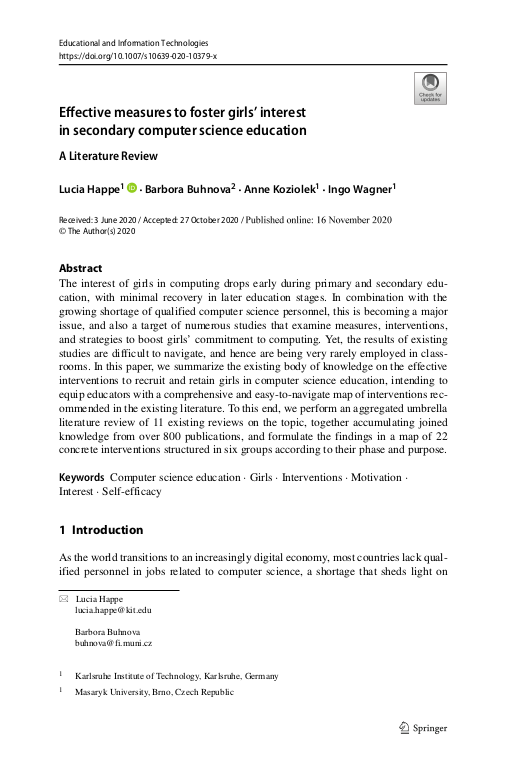The Confidence Gap, Not the Interest Gap
Why girls really leave computer science and how we fix it
“Girls don’t opt out of computer science because they’re uninterested. They opt out because they feel like novices—and we don’t help them.”
This one sentence turns a decade of well-meaning initiatives on their head.
For years, we’ve assumed the problem was image: that girls didn’t see themselves in tech. So we gave them pink robots, posters of Ada Lovelace, and mentorship campaigns. But what if the core issue isn’t how computer science looks, but how it feels?
This umbrella review gathered the findings from over 800 studies on gender and computing. Instead of pointing fingers at girls’ supposed lack of interest, it uncovered something more urgent and, even better, more fixable.

The game-changer? Girls aren’t lacking role models or exposure. They’re lacking confidence. And classrooms are quietly set up to drain it.
When Girls Feel Like Guests
Imagine walking into a room where most people have a year’s head start, where the teacher’s attention goes to the loudest voice, and where your groupmates do the hands-on work while you take notes “just to help out.”
This is how many girls experience their first computer science class.
By the time they hit high school, boys often spend more hours gaming, coding, or tinkering. This early exposure snowballs; boys dominate discussions, monopolise teachers’ time, and dominate group work. Girls hang back, unsure if they belong.
And here’s the kicker: it’s not just girls who fall into this trap. Boys with less experience do, too. But girls are statistically more likely to be placed in the “novice” role and stay there.
This isn’t a lack of ability. It’s a lack of opportunity to build self-efficacy: the simple, powerful belief that I can do this.
The Vicious Cycle of “I’m Not Good at This”
What happens when we teach computing as a fast-moving, logic-first subject? When does success mean solving abstract problems quickly, alone, and with little room for trial and error?
We reward a narrow skillset. One that mirrors how many boys (but not all!) tend to play and learn.
Meanwhile, girls who might excel in collaboration, design, or inquiry-based problem solving don’t get to use those strengths. And when those strengths aren’t valued, they believe they’re not “computer science material.”
“If I fail here, maybe this isn’t for me.”
That thought kills careers before they begin.
The Fix: Change the Classroom, Not the Girls
Here’s the radical insight: girls thrive when classrooms shift how they teach.
The review found 22 evidence-backed interventions, but a few stand out as absolute game changers:
- Split classes by experience, not gender. Don’t let the confident few monopolise the space.
- Start with visual, creative, real-world activities. Think animations, data stories, art, not just loops and variables.
- Celebrate collaboration and design, not just code speed. There’s more to CS than solving problems fast.
- Normalise failure. Teach students to try, not to be right on the first go.
And perhaps most importantly:
- Train teachers to see and support struggling students before they disappear.
Because confidence doesn’t grow in a vacuum. It grows when someone sees your potential before you do.
Let Them Be Beginners
The takeaway? Girls don’t need more persuasion. They need more chances to feel competent.
When teachers create space for different learning styles, starting points, and strengths, girls stay, succeed, and lead.
This isn’t just about gender equity. It’s about fixing a broken pipeline, one that leaks not because people aren’t interested, but because they don’t feel welcome.
So let’s stop asking how to “make computer science cool for girls.”
Let’s ask instead: How do we make computer science a place where beginners of all kinds can belong?
When we do that, we don’t just fix the gender gap; we redesign computing to be better for everyone.
This paper summarizes the existing body of knowledge on the effective interventions to recruit and retain girls in computer science education, intending to equip educators with a comprehensive and easy-to-navigate map of interventions recommended in the existing literature.
